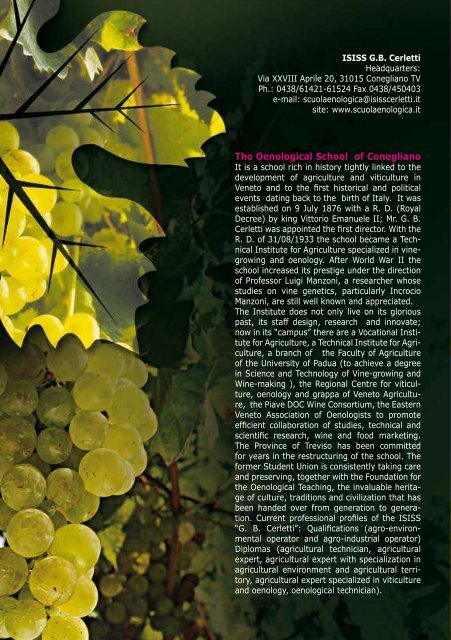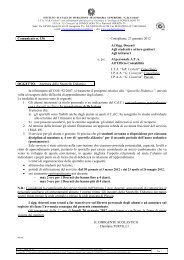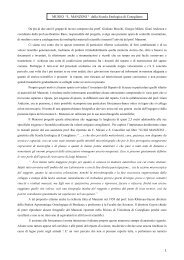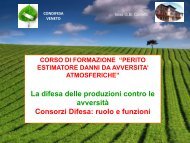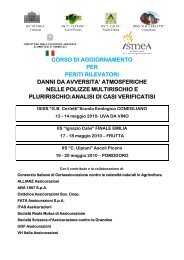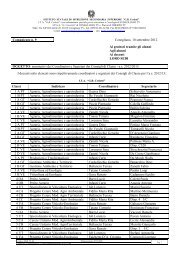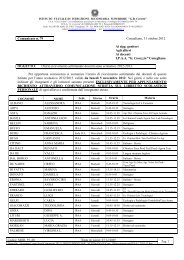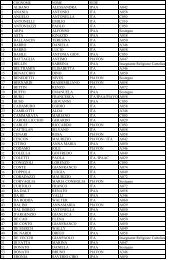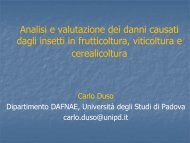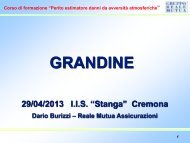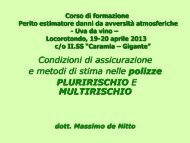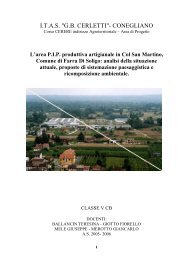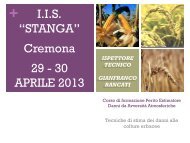#4 WINE CHAMPIONSHIP
#4 WINE CHAMPIONSHIP
#4 WINE CHAMPIONSHIP
Create successful ePaper yourself
Turn your PDF publications into a flip-book with our unique Google optimized e-Paper software.
ISISS G.B. Cerletti<br />
Headquarters:<br />
Via XXVIII Aprile 20, 31015 Conegliano TV<br />
Ph.: 0438/61421-61524 Fax 0438/450403<br />
e-mail: scuolaenologica@isisscerletti.it<br />
site: www.scuolaenologica.it<br />
The Oenological School of Conegliano<br />
It is a school rich in history tightly linked to the<br />
development of agriculture and viticulture in<br />
Veneto and to the first historical and political<br />
events dating back to the birth of Italy. It was<br />
established on 9 July 1876 with a R. D. (Royal<br />
Decree) by king Vittorio Emanuele II; Mr. G. B.<br />
Cerletti was appointed the first director. With the<br />
R. D. of 31/08/1933 the school became a Technical<br />
Institute for Agriculture specialized in vinegrowing<br />
and oenology. After World War II the<br />
school increased its prestige under the direction<br />
of Professor Luigi Manzoni, a researcher whose<br />
studies on vine genetics, particularly Incrocio<br />
Manzoni, are still well known and appreciated.<br />
The Institute does not only live on its glorious<br />
past, its staff design, research and innovate;<br />
now in its “campus” there are a Vocational Institute<br />
for Agriculture, a Technical Institute for Agriculture,<br />
a branch of the Faculty of Agriculture<br />
of the University of Padua (to achieve a degree<br />
in Science and Technology of Vine-growing and<br />
Wine-making ), the Regional Centre for viticulture,<br />
oenology and grappa of Veneto Agriculture,<br />
the Piave DOC Wine Consortium, the Eastern<br />
Veneto Association of Oenologists to promote<br />
efficient collaboration of studies, technical and<br />
scientific research, wine and food marketing.<br />
The Province of Treviso has been committed<br />
for years in the restructuring of the school. The<br />
former Student Union is consistently taking care<br />
and preserving, together with the Foundation for<br />
the Oenological Teaching, the invaluable heritage<br />
of culture, traditions and civilization that has<br />
been handed over from generation to generation.<br />
Current professional profiles of the ISISS<br />
“G. B. Cerletti”: Qualifications (agro-environmental<br />
operator and agro-industrial operator)<br />
Diplomas (agricultural technician, agricultural<br />
expert, agricultural expert with specialization in<br />
agricultural environment and agricultural territory,<br />
agricultural expert specialized in viticulture<br />
and oenology, oenological technician).<br />
School tour 23 March 2009<br />
Wine shop<br />
The original construction of purely Italian architectural style<br />
arises to the left of the main building; it was wanted by Arturo<br />
Marescalchi and John Dalmasso, built on the drawing of the<br />
engineer Bernardo Carpenè, decorated by professor Enrico De<br />
Falco and furnished by professor Giovanni Marsili. It was opened<br />
in 1927 on the 50th anniversary of the foundation of the Royal Oenological<br />
School.<br />
The Oenological School Aula Magna (Assembly Hall)<br />
The style of the austere Room dates back to the first Renaissance modernised with solemn dignity.<br />
In this room you can see the decorations of the ceiling and the walls with scenes of merry and joyful<br />
life linked to the vine and the wine. These works are by the painter Antonio Morera. He represented<br />
the rural labour and the virtues derived from it, as well as the wellness given by the wine to humanity.<br />
There is also a second copy of the Young Bacchus by Sansovino. The original is in Florence at the<br />
National Museum of the Bargello.<br />
The tasting room<br />
It follows a Florentine room of Renaissance style. There are two cupboards containing handmade<br />
blown glasses and containers of various shape and colour. In the middle of the room there is a table in<br />
the shape of a horseshoe, intended for pupils’ tasting sessions.<br />
Department of Science<br />
In this prestigious Department, where the distinguished professor Manzoni in the 1930s did many<br />
studies and important researches on the vine, examples of the dried Italian Flora are preserved, a<br />
collection of approximately 2000 species of plants the classification of which was contributed by distinguished<br />
botanists such as Cuboni, Pichi, De Carli; the Entomological collection of around 5000 species<br />
by Federico Huster; the prestigious Saccardo mycotheque.<br />
The Oenological School cellar<br />
Particularly important among the departments is the cellar. The wines produced are those typical of<br />
the DOC Prosecco area , of Conegliano Colli wines and IGT.<br />
The school also produces special wines: “Manzoni Liquoroso” and “Passione” both liqueur wines.<br />
Finally, the school operates in collaboration with Veneto Agriculture and the Tutelary Institute of Veneto<br />
grappa, the experimental distillery, where grappa is produced.


